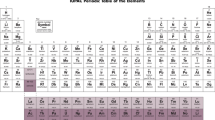Abstract
Mössbauer spectroscopy can be a useful structural tool to assist crystallographic methods for site assignment when the compound under investigation contains divalent tin. The goal of this work was to show that the structure of tin(II) fluoride, also know as stannous fluoride, SnF2, could have been solved 14 years earlier if Mössbauer spectroscopic results, already known, had been used. A first attempt to solve the crystal structure, carried out by Bergerhoff in 1962 seemed to find the tin positions, however, it failed to find the positions of fluorine. Further extensive studies by Dénès et al. in the mid 1970s yielded the same results as those of Bergerhoff, despite the use of a Nonius CAD-4 automatic diffractometer, in contrast with Bergerhoff’s film work. The tin positions yielded a residual of 0.23, and Fourier difference maps showed significant electron density that could be fluorine atoms, however, their number did not match the number of fluorine atoms expected and several F-F distances were way too short. In addition, refinement using these possible fluorine positions led to no improvement of the residual factor. Finally, the crystal structure was published by McDonald et al. in 1976. It was found that the tin sublattice determined by Bergerhoff was basically correct, except that half of the tin atoms found by Bergerhoff to be on the (4b) and (4e) special Wyckoff sites were actually on the (8f) general site. A translation of the origin of the unit-cell by the [1/8, 0, 3/16] vector allows to change the tin Wyckoff sites from (4b), (4e) and (8f) to two (8f) sites, while keeping the basic spatial distribution of tin. A method has now been designed, using 119Sn Mössbauer spectroscopy, to test the suitability of some Wyckoff sites for divalent tin, using the Mössbauer spectrum. The tin(II) doublet (δ = 3.430(3) mm/s, Δ = 1.532(3) mm/s) shows that the lone pair is on a hybrid orbital, therefore, it is stereoactive, and it results that tin cannot be on either the (4b) or (4e) tin site since both an inversion center and a 2-fold axis would generate a second lone pair unless the 2-fold axis were along the tin-lone pair axis.
Similar content being viewed by others
References
Nebergall, W.M.H., Mueller, J.C., Day, H.G.: J. Am. Chem. Soc. 74, 1604 (1952)
Acker, E., Haussühl, S., Recker, K.: J. Cryst. Growth 13/14, 467 (1972)
Dénès, G.: Mater. Res. Bull. 15, 807 (1980)
Dénès, G.: J. Solid State Chem. 37, 16 (1981)
Dénès, G., Pannetier, J., Lucas, J.: J. Solid State Chem. 33, 1 (1980)
Pannetier, J., Dénès, G., Durand, M., Buevos, J.L.: J. Phys. (Paris) 41, 1019 (1980)
Bergerhoff, G.: Acta Cryst. 15, 509 (1962)
Dénès, G., Pannetier, J., Lucas, J., Le Marouille, J.Y.: J. Solid State Chem. 30, 335 (1979), and references therein
McDonald, R.C., Ho-Kuen Hau, H., Eriks, K.: Inorg. Chem. 15, 762 (1976)
Ruebenbauer, K., Birchall, T.: Hyperfine Interact 7, 125 (1979)
Donaldson, J.D., Oteng, R., Senior, B.J.: J. Chem. Soc. Chem. Comm. 618 (1965)
Birchall, T., Dénès, G., Ruebenbauer, K., Pannetier, J.: J. Chem. Soc. Dalton 1831 (1981)
Hien, P.Z., Shpinel, V.S., Viskov, A.S., Venevtsev, Yu.N.: Zhur. Eksp. Teor. Fiz. 44, 1889 (1963) [Soviet Physics – JEPT 17 (1963), 1271]
Birchall, T., Dénès, G., Ruebenbauer, K., Pannetier, J.: Hyperfine Interact. 30, 167 (1986)
Dénès, G., Laou, E.: Hyperfine Interact. 92, 1013 (1994)
Dénès, G., Muntasar, A.: Hyperfine Interact. 153, 121 (2004)
Galy, J., Meunier, G., Andersson, S., Aström, A.: J. Solid State Chem. 13, 142 (1975)
Brown, I.D.: J. Solid State Chem. 11, 214–233 (1974)
Greenwood, N.N., Gibb, T.C.: Mössbauer Spectroscopy, pp. 607–611. Chapman and Hall, London (1971)
Birchall, T., Dénès, G., Ruebenbauer, K., Pannetier, J.: J. Chem. Soc. Dalton 2296 (1981)
Birchall, T., Dénès, G., Ruebenbauer, K., Pannetier, J.: Hyperfine Interact. 29, 1327 (1986)
Boyle, A.J.F., Bunbury, D.St.P., Edwards, C.: Proc. Phys. Soc. 79, 416 (1962)
Author information
Authors and Affiliations
Corresponding author
Additional information
Proceedings of the 32nd International Conference on the Applications of the Mössbauer Effect (ICAME 2013) held in Opatija, Croatia, 1–6 September 2013
Rights and permissions
About this article
Cite this article
Dénès, G., Merazig, H. & Muntasar, A. Using Mössbauer spectroscopy to choose the sites that can be occupied by divalent tin. Hyperfine Interact 226, 79–87 (2014). https://doi.org/10.1007/s10751-014-1012-0
Published:
Issue Date:
DOI: https://doi.org/10.1007/s10751-014-1012-0




